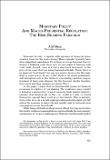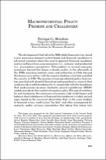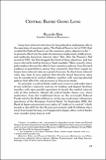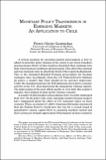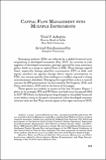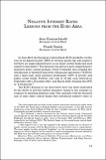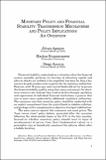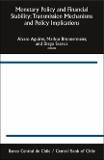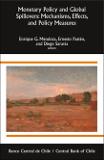Buscar
Mostrando ítems 41-49 de 49
Monetary policy and macro-prudential regulation: the risk-sharing paradigm
Economic history is replete with episodes of financial crises creating havoc for the real economy. These episodes typically have three important ingredients. First there are large financial flows to finance a bubbling asset class such as sovereigns or housing with 'safe' debt. Second there is a sharp ...
Macroprudential policy: promise and challenges
The developments that led to the 2008 global financial crisis raised a new awareness amongst central banks and financial regulators in advanced economies about the need to approach financial regulation and surveillance from a macroeconomic (i.e. systemic) and prudential (i.e. pre-emptive) perspective. ...
Central banks going long
Long-term interest rates have for long played an ambiguous role in the operation of monetary policy. The Federal Reserve Act of 1913 that created the Federal Reserve set the monetary policy objective to be: '... to promote effectively the goals of maximum employment stable prices and moderate long-term ...
Monetary policy transmission in emerging markets: an application to Chile
A critical question for emerging-market policymakers is how to adjust to monetary policy changes in the center. A core tenet of modern macroeconomic theory is that countries should let their exchange rate float when financial conditions abroad change. This allows the nominal and real exchange rates ...
Capital flow management with multiple instruments
Emerging markets (EMs) are affected by a global financial cycle originating in developed economies (Rey 2013). An increase in risk appetite of developed economies perhaps spurred by easy monetary policy leads to a surge in capital flows to EMs. These foreign capital flows especially foreign portfolio ...
Negative interest rates: lessons from the Euro area
In June 2014 the European Central Bank (ECB) decided to cut the rate on its deposit facility (DFR) by 10 basis points (bp) into negative territory an unprecedented move as no major central bank had used negative rates before. This decision was part of a more comprehensive monetary policy easing package ...
Monetary policy and financial stability: transmission mechanisms and policy implications: an overview
Financial stability understood as a situation when the financial system smoothly performs its function of allocating capital and adverse shocks are unlikely to be amplified has been for long a key concern for policymakers and in particular for monetary authorities. However until 10 years ago most ...
Monetary policy and financial stability: transmission mechanisms and policy implications
The global financial crisis that broke out 10 years ago uncovered the buildup of risks during a period of price and output stability. It challenged the previous consensus that preserving price stability was the optimal way to ensure financial stability, and led to a surge of interest in the multiple ...
Monetary policy and global spillovers: mechanisms, effects and policy measures
Central Banks in emerging markets have been forced in the last decade to deal with spillovers from the crises in the United States and Europe and from the extraordinary measures respectively taken by the Federal Reserve and the European Central Bank. This volume provides a comprehensive study of the ...

